



A spectacular fireball lit up the predawn sky above Northern Sudan on October 7, 2008. This explosion was caused by the atmospheric entry of a small near-Earth asteroid, estimated to be no more than a few meters in diameter. The explosion likely scattered small meteorite fragments across the Nubian desert below. Although such small impact events occur several times per year around the globe, this case was unprecedented because the asteroid was actually discovered the day before it reached the Earth and the impact location and time were for the first time predicted in advance.
At 6:39 UT (UT = GMT) on the morning of October 6, 2008, Richard Kowalski, at the Catalina Sky Survey, discovered this small near-Earth asteroid using the Mt. Lemmon 1.5 meter aperture telescope near Tucson, Arizona. When the discovery observations were reported to the Minor Planet Center (MPC) in Cambridge Massachusetts, a preliminary orbit computation immediately indicated that the object was headed for an Earth impact within 21 hours. The MPC quickly made the discovery and subsequent “follow-up” observations available to the astronomical community and contacted the NASA/JPL Near-Earth Object Program Office. The MPC also notified NASA Headquarters of the impending impact so that subsequent US government interagency alerts and inter-governmental notifications could begin. By the time this object (now designated as 2008 TC3) entered the Earth’s shadow 19 hours after discovery, some 570 astrometric (positional) measurements had been reported from 26 observatories around the world, both professional and amateur.
Within an hour of receiving the initial data set, JPL predicted that the object would enter the Earth’s atmosphere above northern Sudan around 02:46 UT on October 7. As the day progressed and more and more data arrived from the MPC, JPL continued to improve the orbit for 2008 TC3 and forwarded updated predictions to NASA Headquarters. On the afternoon of Oct 6th, NASA Headquarters alerted officials at the National Security Council, the Office of Science and Technology Policy, the Department of State, and the Department of Defense Northern Command and Joint Space Operations Center. NASA also issued a press release at approximately 21:30 UT announcing the predicted impact later that night.
Detections of the actual atmospheric impact event suggested that it was an airburst explosion at an altitude of 37 km with an energy equivalent to about one kiloton of TNT explosives. The time and place of the predicted impact agree very well with a number of atmospheric entry observations including those from U.S. government satellites, infrasound signals from at least one ground station, images from the Meteosat 8 weather satellite and a sighting by a KLM airline pilot flying over Chad. The latest JPL trajectory estimate, which carefully considers all available data, including some measurements not available until after the event, is accurate to within a few kilometers at the time of atmospheric entry.
This dramatic prediction of an actual impact underscored the successful evolution of the Near-Earth Object (NEO) Program’s discovery and orbit prediction process. The discovery was made, observations were provided by 26 international observatories, the orbit and impact computations were determined, verified and announced well before the impact, which took place only 20.5 hours after the discovery itself. While improvements to the impact prediction process still need to be made, the system worked well for the first predicted impact by a near-Earth object.
The relative velocity of the 2008 TC3 as it entered the atmosphere was 12.4 km/s. It was on a shallow, near-grazing impact, arriving from a direction 20.0 degrees above horizontal and from an azimuth of 281.6 degrees, which is nearly west to east. Based on the measured brightness of the object in space, and assuming typical reflectance properties of near-Earth asteroids, it was estimated to be in the range of 2-5 meters in diameter. This places the kinetic energy at around 1 kiloton of TNT, give or take a factor of two. Analyses of detections of the entry by U.S. government satellites and ground-based very low frequency infrasound measurements also suggest a total kinetic energy of about 1 kT (Brown, 2008a,b,c; Johnson, 2008).
Harris (2008) provided information on the object’s light curve, which indicates a rapidly tumbling spin state. Marek Kozubal and Ron Dantowitz, two Massachusetts amateur astronomers, observed 2008 TC3 with a fast read out photometer. They supplied these photometric data to Al Harris who de-trended these data for 3 magnitudes of brightening, and then sent his results to Petr Pravec who ran the light curve analysis and determined the object was in a non-principal axis rotation state (i.e., it was tumbling or wobbling) with the two principal rotation periods being 97 and 49 seconds. Figures 1a and 1b provide illustrations of the asteroid’s approach to Earth. Note that the object entered the Earth’s shadow at 01:49 UT, nearly an hour before atmospheric entry, so that ground-based astrometric observations ceased at that point.
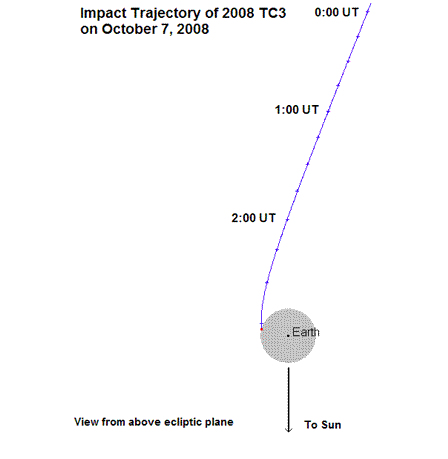
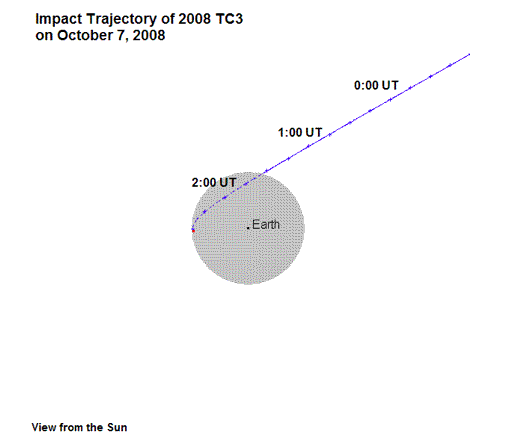
Table 1. The observed times and locations of atmospheric entry and airburst reported by US government satellites are compared to the JPL trajectory predictions for the same altitude. There is excellent agreement especially in light of the observed time uncertainty introduced by round off and the necessarily imprecise nature of the observed events. The observed data were taken from Brown (2008a) and Johnson (2008).
| Event | Atmospheric Entry | Airburst Detonation |
|---|---|---|
| Altitude (km) | 65.4 | 37 |
| Observed Event Time (UT) | 02:45:40 | 02:45:45 |
| Predicted Event Time (UT) | 02:45:38.45 | 02:45:45.13 |
| Observed Long./Lat. (deg.) | 31.4E 20.9N | 32.2E 20.8N |
| Predicted Long./Lat. (deg.) | 31.412E 20.933N | 32.140E 20.793N |
Figure 2 provides the latitude and longitude coordinates for the object’s positions at 10 km increments from 100 km altitude down to the surface. Although atmospheric effects were not considered, the predicted positions of the object agree well with the reported atmospheric coordinates for atmospheric entry (at 65.4 km) and the airburst event (at 37 km), which are plotted as red stars on the illustration. Figure 3 presents the uncertainty footprint of the impact predictions for an altitude of 50 km.
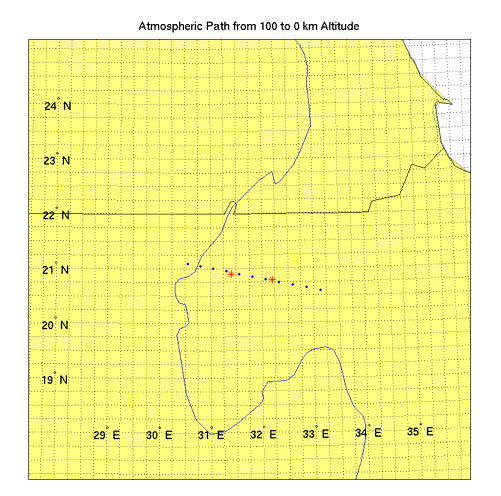
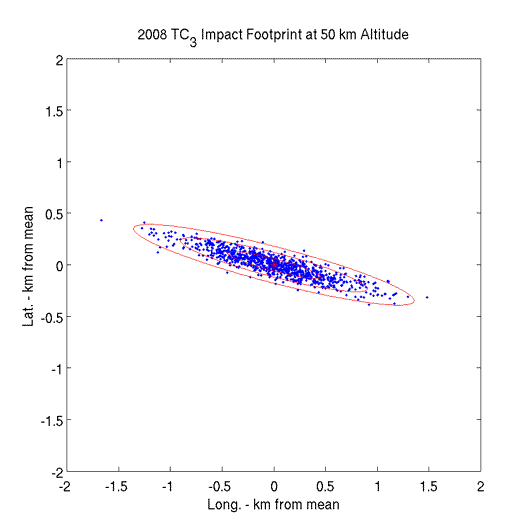
The fireball event was observed visually, in the infrared, and by very low frequency infrasound devices.
Borovicka (2008) reported visual and infrared observations of the event taken from the Meteosat 8 satellite on October 7 at approximately 2:45 UT. The spot (see Figure 4) was apparent in all 12 satellite spectral channels, spanning wavelengths from the visible to infrared. The estimated timing and position in the Meteosat 8 images is imprecise, but roughly consistent with the JPL orbit estimate.
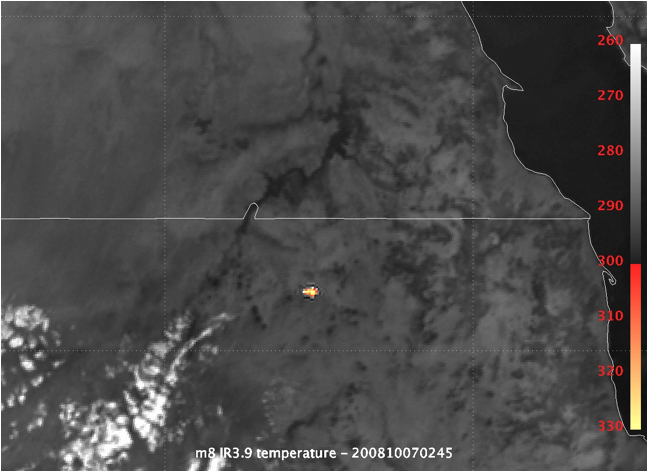
Brown (2008a) provides information on the event derived from U.S. Government satellites (See Table 1). Elsewhere, he reported that the radiated energy was equivalent to approximately 0.1 kT (Brown 2008b), which is again consistent with an overall kinetic energy of about 1 kT. Brown also suggested that 2008 TC3 had a rather low mechanical strength, saying “the height which is quoted for the detonation (37 km) is unusually high for an object of this energy and (from the orbit solutions) low entry velocity. This is almost exactly the same initial burst height as recorded for the (faster) Tagish Lake fireball, which also had the same entry angle. I would caution making direct compositional comparisons, but it does certainly underscore the global weakness of the object compared to chondritic objects and I think can be used to all but rule out something as strong as an iron (for example).”
Kuiper (2008) reported that the pilot and co-pilot for a KLM flight over Chad saw the impact flash after they had been alerted to watch for the event. Captain Ron de Poorter and co-pilot Coen van Uden were flying their 747-400 from Johannesburg to Amsterdam during that night of Oct 6th -7th. When they received the alert-message about 2008 TC3 from the KLM dispatcher, their position was over Chad. At 0244 UT they began continuously observing the horizon in the east-north-east sector of their sight. They had put the received coordinates in their navigation system and concluded that, compared to their plane’s heading (which was at that moment 348 degrees, almost NNW), they had to look at a bearing of 68-70 degrees, in clockwise terms looking at ‘half past two’. At UT 02:45:40 seconds they saw the sky above the part of the horizon they were looking at, suddenly brightening by a light flash. In approximately one and a half seconds, this “lightning” was 2 to 3 times more visible.
A clever, remote use of an Egyptian webcam on a Red Sea beach may have captured the flash from the airburst. The web cam was located some 725 km north of the impact site and was pointed away from the impact direction. Nevertheless, the camera did capture the brightening of foreground objects illuminated by the flash. See: http://home.pages.at/thie/asteroid_2008_tc3/
Brown (2008c) reported that preliminary examinations of several infrasound stations nearest to the predicted impact point for the NEO 2008 TC3 has yielded at least two definite airwave detection from the impact. The data are consistent with the predicted arrival direction and time and suggest a kinetic energy of about 1.1 - 2.1 kilotons of TNT.
Brown, Peter (2008a). http://aquarid.physics.uwo.ca/~pbrown/usaf/usg282.txt
Brown, Peter (2008b). Email received October 7, 2008.
Brown, Peter (2008c). Email received Oct. 9, 2008
Borovicka (2008). Event reported on IAU Circular 8994, Central Bureau of Astronomical Telegrams, Smithsonian Astrophysical Observatory, Cambridge, MA, Oct. 8, 2008.
Harris, Alan (2008). Results reported at the Oct. 2008 AAS Division of Planetary Sciences Conference at Cornell University.
Johnson, Lindley (2008). Email received by D.K. Yeomans on Oct. 7, 2008.
Kuiper, Jacob (2008). Emailed report received by D.K. Yeomans on Oct. 16, 2008 es Conference at Cornell University.
Johnson, Lindley (2008). Email received by D.K. Yeomans on Oct. 7, 2008.
Kuiper, Jacob (2008). Emailed report received by D.K. Yeomans on Oct. 16, 2008
Johnson, Lindley (2008). Email received by D.K. Yeomans on Oct. 7, 2008.
Kuiper, Jacob (2008). Emailed report received by D.K. Yeomans on Oct. 16, 2008